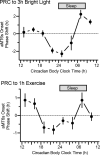Circadian acclimatization of performance, sleep, and 6-sulfatoxymelatonin using multiple phase shifting stimuli
- PMID: 36465660
- PMCID: PMC9710383
- DOI: 10.3389/fendo.2022.964681
Circadian acclimatization of performance, sleep, and 6-sulfatoxymelatonin using multiple phase shifting stimuli
Abstract
Misalignment between the environment and one's circadian system is a common phenomenon (e.g., jet lag) which can have myriad negative effects on physical and mental health, mental and physiological performance, and sleep. Absent any intervention, the circadian system adjusts only 0.5-1.0 h per day to a shifted light-dark and sleep-wake schedule. Bright light facilitates circadian adjustment, but in field studies, bright light is only modestly better than no stimulus. Evidence indicates that exercise and melatonin can be combined with bright light to elicit larger shifts but no study has combined all of these stimuli or administered them at the times that are known to elicit the largest effects on the circadian system. The aims of this study are to compare the effects of different treatments on circadian adjustment to simulated jet lag in a laboratory. Following 2 weeks of home recording, 36 adults will spend 6.5 consecutive days in the laboratory. Following an 8 h period of baseline sleep recording on the participant's usual sleep schedule on Night 1 (e.g., 0000-0800 h), participants will undergo a 26 h circadian assessment protocol involving 2 h wake intervals in dim light and 1 h of sleep in darkness, repeated throughout the 26 h. During this protocol, all urine voidings will be collected; mood, sleepiness, psychomotor vigilance, and pain sensitivity will be assessed every 3 h, forehead temperature will be assessed every 90 min, and anaerobic performance (Wingate test) will be tested every 6 h. Following, the circadian assessment protocol, the participant's sleep-wake and light dark schedule will be delayed by 8 h compared with baseline (e.g., 0800-1400 h), analogous to travelling 8 times zones westward. This shifted schedule will be maintained for 3 days. During the 3 days on the delayed schedule, participants will be randomized to one of 3 treatments: (1) Dim Red Light + Placebo Capsules, (2) Bright Light Alone, (3) Bright Light + Exercise + Melatonin. During the final 26 h, all conditions and measures of the baseline circadian protocol will be repeated. Acclimatization will be defined by shifts in circadian rhythms of aMT6s, psychomotor vigilance, Wingate Anaerobic performance, mood, and sleepiness, and less impairments in these measures during the shifted schedule compared with baseline. We posit that Bright Light Alone and Bright Light + Exercise + Melatonin will elicit greater shifts in circadian rhythms and less impairments in sleep, mood, performance, and sleepiness compared with Dim Red Light + Placebo Capsules. We also posit that Bright Light + Exercise + Melatonin will elicit greater shifts and less impairments than Bright Light Alone.
Keywords: bright light; circadian misalignment; exercise; jet lag disorder; melatonin.
Copyright © 2022 Youngstedt, Elliott, Patel, Zi-Ching Mak, Raiewski, Malek, Strong, Mun, Peters, Madlol, Tasevska, Rasoul, Nguyen, Vargas Negrete, Adaralegbe, Sudalaimuthu, Granholm, Finch, Eksambe, Malready and Parthasarathy.
Conflict of interest statement
The authors declare that the research was conducted in the absence of any commercial or financial relationships that could be construed as a potential conflict of interest.
Figures





Similar articles
-
Timely use of in-car dim blue light and blue blockers in the morning does not improve circadian adaptation of fast rotating shift workers.Chronobiol Int. 2021 May;38(5):705-719. doi: 10.1080/07420528.2021.1872592. Epub 2021 Feb 15. Chronobiol Int. 2021. PMID: 33588653
-
Phase advancing human circadian rhythms with morning bright light, afternoon melatonin, and gradually shifted sleep: can we reduce morning bright-light duration?Sleep Med. 2015 Feb;16(2):288-97. doi: 10.1016/j.sleep.2014.12.004. Epub 2014 Dec 18. Sleep Med. 2015. PMID: 25620199 Free PMC article.
-
A compromise phase position for permanent night shift workers: circadian phase after two night shifts with scheduled sleep and light/dark exposure.Chronobiol Int. 2006;23(4):859-75. doi: 10.1080/07420520600827160. Chronobiol Int. 2006. PMID: 16887753
-
Circadian rhythm sleep disorders: pathophysiology and potential approaches to management.CNS Drugs. 2001;15(4):311-28. doi: 10.2165/00023210-200115040-00005. CNS Drugs. 2001. PMID: 11463135 Review.
-
Jet lag: minimizing it's effects with critically timed bright light and melatonin administration.J Mol Microbiol Biotechnol. 2002 Sep;4(5):463-6. J Mol Microbiol Biotechnol. 2002. PMID: 12432956 Review.
Cited by
-
Medium- and Long-Term Effects of Insomnia Severity and Circadian Preference on Pain and Emotional Distress Among Individuals With Chronic Pain.J Pain. 2023 Nov;24(11):1946-1956. doi: 10.1016/j.jpain.2023.05.017. Epub 2023 Jun 5. J Pain. 2023. PMID: 37286095 Free PMC article.
-
Reflections on Several Landmark Advances in Circadian Biology.J Circadian Rhythms. 2024 Apr 1;22:1. doi: 10.5334/jcr.236. eCollection 2024. J Circadian Rhythms. 2024. PMID: 38617711 Free PMC article. Review.
-
Human-Centric Lighting Research and Policy in the Melanopsin Age.Policy Insights Behav Brain Sci. 2023 Oct;10(2):237-246. doi: 10.1177/23727322231196896. Epub 2023 Oct 26. Policy Insights Behav Brain Sci. 2023. PMID: 38919981 Free PMC article.
-
Association between sleep-wake schedules and myopia among Chinese school-aged children and adolescents: a cross-sectional study.BMC Ophthalmol. 2023 Apr 3;23(1):135. doi: 10.1186/s12886-023-02874-9. BMC Ophthalmol. 2023. PMID: 37013536 Free PMC article.
-
Timely Questions Emerging in Chronobiology: The Circadian Clock Keeps on Ticking.J Circadian Rhythms. 2024 Apr 2;22:2. doi: 10.5334/jcr.237. eCollection 2024. J Circadian Rhythms. 2024. PMID: 38617710 Free PMC article. Review.
References
Publication types
MeSH terms
Substances
LinkOut - more resources
Full Text Sources

